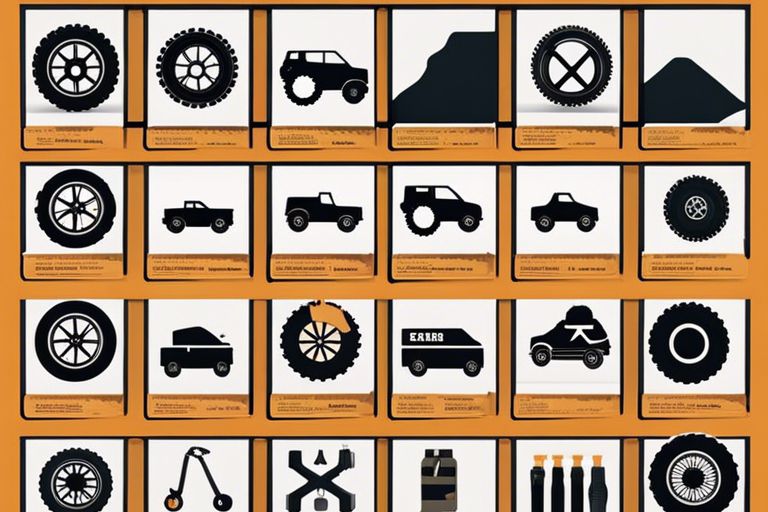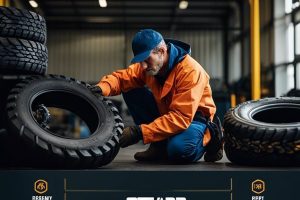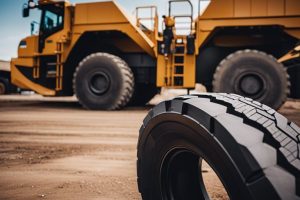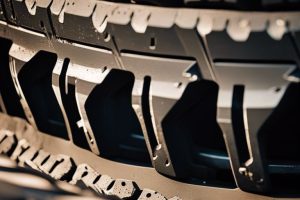Gathering the perfect off-the-road (OTR) tires to navigate different terrains is imperative to ensure the safety, performance and longevity of your heavy-duty vehicles. With a plethora of options available, it can be difficult to understand the nuances of tire choice. In this comprehensive guide, we explore the intricacies of selection the most suitable earth-moving tyres for different terrains ranging from rocky surfaces to muddy trails. By the end of this manual, you will have the knowledge to make informed decisions and maximize the capabilities of your vehicle.
Key learning points:
- Understand the terrain: It is critical to assess the specific terrain conditions in which the OTR tires will be used to determine the correct tread pattern, rubber compound and tire construction required.
- Choose the right tread pattern: Select a tread pattern to suit the terrain, such as tread design for muddy conditions, block tread for rocky surfaces or ribbed patterns for slippery roads.
- Take the tire size and load capacity into account: To optimize performance and safety, ensure OTR tires are the correct size for your vehicle and have the necessary load capacity to support the weight of the equipment.
Understanding OTR Bands
If you are looking for Off-The-Road (OTR) tires, it is crucial to have a good understanding of their composition, features and types. OTR tires are specially designed for vehicles that travel on rough terrain such as construction sites, mines, quarries and agricultural fields. These tires play a crucial role in ensuring the efficiency and safety of heavy machinery in challenging environments.
Composition and characteristics
Being at a basic level OTR tires composed of rubber compounds, fabric, steel belts and other materials designed to withstand harsh conditions. These tires are significantly larger than regular tires and provide the stability and durability needed for heavy equipment to work in demanding terrain. The tread patterns on OTR tires are specifically designed to provide traction and grip on various surfaces, such as rocks, mud, sand and gravel.
The characteristics of OTR tires include their ability to carry heavy loads, resist cuts and punctures, and maintain stability at low air pressure. These tires are also built to withstand extreme temperatures and weather conditions, making them ideal for all-season use in challenging environments. It is critical to choose the right OTR tire based on the specific requirements of the job site and the type of machine being used.
Types of OTR tires
There are several types of OTR tires available on the market, each designed for specific applications and terrain. Some common types include sturdy tires, pneumatic tires, radial tires, diagonal tires, And flotation tires. Solid tires are filled with rubber compound, making them puncture resistant and ideal for rough terrain. Pneumatic tires are filled with air and provide a dampening effect, suitable for softer surfaces. Radial tires feature steel belts that run perpendicular to the direction of travel, providing better traction and longer tread life.
- Sturdy tires – puncture resistant and durable.
- Pneumatic tires – provide cushioning and shock absorption.
- Radial tires – provide better traction and longer tread life.
- Bias ply tires – cost-saving and suitable for heavy loads.
- Flotation tires – designed for minimal soil compaction.
It is critical to select the correct type of OTR tire based on the specific terrain, weather conditions and equipment requirements. Consult tire experts or manufacturers to determine which tire is best suited to your needs. Thorough Research and proper selection can improve the performance and efficiency of your heavy machinery while ensuring safety and durability in challenging environments.
| Type | Characteristics |
| Sturdy tires | Puncture resistant, durable |
| Pneumatic tires | Damping, shock absorption |
| Radial tires | Better traction, longer tread life |
| Bias ply tires | Cost-effective, heavy load capacity |
| Flotation tires | Minimal soil compaction |

Factors to consider when selecting OTR tires
Any construction or industrial project involving off-the-road (OTR) vehicles requires careful consideration in their selection OTR tires to ensure optimal performance and safety. There are several important factors to consider before making a purchasing decision.
- Tire size and pattern: On any terrain, the size and pattern of the OTR tires play a crucial role in determining traction, stability and overall performance. The size of the tire must be compatible with the vehicle and terrain it will travel on. The tread pattern must be suitable for the specific terrain to ensure maximum grip and agility.
- Payload and speed rating: Tires should be selected based on the loading capacity they can handle and the speed rating required for the application. Overloading tires or exceeding the speed limit can lead to premature wear and potential safety hazards. It is imperative to match the load capacity and speed rating of the tires to the requirements of the project.
Tire size and pattern
On the right at every construction site OTR tires the right size and pattern can make a significant difference in vehicle performance. The size of the tire affects ground clearance, while the tread pattern determines how much traction and grip the tire can provide. By carefully choosing the right tire size and tread pattern, you can ensure that your vehicles can operate effectively on different terrains without any problems.
Payload and speed rating
Tires designed for off-road use come with specified specifications loading capacities And speed ratings to ensure safe operation. The load rating indicates the maximum weight a tire can carry, while the speed index determines the top speed at which the tire can be driven safely. It is crucial to adhere to these specifications to avoid tire failures or accidents due to overloading or exceeding speed limits.
Select additionally OTR tires With the right load capacity and speed rating, tire life can be extended and the risk of downtime due to tire-related problems can be minimized. It is always recommended to consult a tire specialist or manufacturer to determine which tires are best suited to your specific project requirements.
How-To tips for different areas
Please make sure you select the correct one OTR tires for different terrains is crucial to optimize performance and ensure safety. Here are some essential tips to help you navigate different types of terrain with confidence:
- Best practices for off-road conditions
- Adaptation to extreme weather terrain
Best practices for off-road conditions
One of the most important aspects of off-roading is the driving to elect the appropriate one OTR tires for the specific terrain you are traversing. To ensure optimal performance, it is crucial to consider factors such as tread pattern, tire size and rubber compound. Additionally, maintaining proper tire pressure is crucial for traction and stability while navigating rough terrain. Regularly inspecting your tires for signs of damage or wear is also important to avoid potential problems while off-roading.
Adaptation to extreme weather terrain
Anytime you encounter extreme weather conditions, such as snow, ice, mud or rain, it is critical that you be prepared with right OTR tires for the job. Snow tires, for example, are specially designed to provide excellent traction and handling in icy conditions. It is crucial to equip your vehicle with tires suitable for the specific weather conditions you will encounter to ensure optimal safety and performance on the road. Understanding the importance of tire choice in extreme weather conditions can make a significant difference in your driving experience. For more information on selecting the right all-terrain tires, visit Everything you need to know about all-terrain tires.
Maintenance and safety
To ensure the longevity and performance of your OTR tires, proper maintenance and safety practices are critical. In this chapter we discuss some important tips to help you keep your tires in top condition and ensure a safe and smooth ride.
Routine checks and care tips
Nasty retain your OTR tires, it is crucial to carry out regular checks and follow some maintenance tips. Start by checking your tire pressure regularly with a tire pressure gauge. Correct pressure not only ensures optimal performance, but also extends the life of the tire. In addition, check the tread depth regularly to ensure sufficient traction on different terrains. Flip your tires regular intervals to promote even wear and maximize service life. Finally, keep an eye out for any signs of uneven wear, bulges or cuts in the tire surface, as these can indicate potential problems that require immediate attention.
- Tire pressure gauge
- Profile depth
- Regular rotation
- Check for signs of wear
Each neglect or inattention in maintaining tires can lead to reduced performance, an increased risk of a tire blowout and reduced overall safety for you and your vehicle. It is crucial to address any issues quickly to avoid expensive repairs or replacements down the road.
Recognizing when tires need to be replaced
Each indication of extensive wear, such as significant tread wear above safe levels, sidewall damage, or frequent punctures, should indicate that the tire needs to be replaced. Ignoring these signs can compromise your safety and the efficiency of your vehicle. In addition, pay attention to any vibrations, unusual noises or drivability issues, as these can also be signs of worn tires that need to be replaced immediately.
Maintenance is the key to ensure the safety and performance of your earth-moving tires. By following a regular maintenance schedule By quickly addressing any issues that arise, you can maximize the life of your tires and enjoy a smooth and safe ride on a variety of terrains.
Conclusion
Ultimately, selecting the right OTR tires for different terrain requires considering several factors, such as tread pattern, tire size, sidewall protection and ply thickness. Understanding the specific requirements of the site you will be operating in is essential to ensuring optimal performance and safety. By following this comprehensive guide and consulting experts in the field, you can make informed decisions that maximize the life and efficiency of your tires while minimizing downtime and maintenance costs. Remember, the right set of OTR tires can make all the difference in the success of your off-road activities.
FAQ
Q: What factors should be considered when selecting OTR tires for different terrains?
A: When choosing OTR tires for different terrain, factors such as tread pattern, tire size, ply thickness and rubber compound should be considered. These factors play a crucial role in the tire's performance and durability in specific terrains.
Question: How does tread pattern affect the performance of OTR tires on different terrains?
A: The tread pattern of OTR tires has a significant impact on their performance on different terrains. For example, tires with aggressive tread patterns are suitable for rough terrains such as rocky or muddy surfaces, as they provide improved traction and self-cleaning properties. On the other hand, tires with less aggressive tread patterns are more suitable for smooth or hard surfaces such as highways or construction sites.
Question: Why is it critical to consider tread thickness and rubber compound when selecting OTR tires for different terrain?
A: Ply rating and rubber compound are crucial factors to consider when choosing OTR tires for different terrain. The ply rating indicates the strength and load-bearing capacity of the tire, making it critical for heavy-duty applications. Meanwhile, the rubber compound affects the tire's traction, wear resistance and overall performance on specific terrains. Selecting the right layer value and rubber compound ensures optimal tire performance and a long lifespan under challenging conditions.


